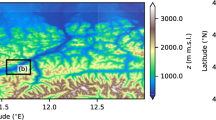Summary
The recovery of windfields from chemical constituents is a difficult, but potentially rewarding inverse problem. Advanced data assimilation methods, such as the extended Kalman filter, are theoretically capable of performing this task; but, at this time, little work has been undertaken. Daley (1994) constructed a one-dimensional extended Kalman filter (EKF) system to examine this problem. This work is extended here to include a more systematic examination of the one-dimensional case, together with experiments with non-divergent two-dimensional flow. The emphasis is on determining when wind recovery is likely to be successful or unsuccessful.
It was found that wind recovery is most successful with the EKF for constituent observations which are dense, frequent and accurate. Wind recovery is difficult or slow for the EKF (or any other procedure) when the true constituent time-tendency is small. This happens when the constituent spatial gradient is small, the true windspeeds are low or the stream-function and constituent fields are highly correlated. Wind recovery can also be difficult with constituent transport models which are highly damped, have significant phase errors or restrictive CFL criteria. Steady winds cannot be recovered inside data voids, although time-dependent winds may be recoverable. If constituent observations are too infrequent, estimates of the constituent time-tendency will be poor, and wind recovery (at least for the EKF) problematic.
Similar content being viewed by others
References
Allen, D., Douglass, A., Rood, R., Gutherie, P., 1991: Application of a monotonic upstream-based transport scheme to three-dimensional constituent transport calculations.Mon. Wea. Rev.,119, 2456–2464.
Austin, J., 1992: Toward the four dimensional assimilation of stratospheric chemical constituents.J. Geophys. Res.,97 D18, 2569–2588.
Cohn, S. E., Dee, D. 1988: Observability of discretized partial differential equations.SIAM J. Numer. Anal.,25, 586–617.
Cohn, S. E., Sivakumaran, N., Todling, R., 1994: A fixed-lag Kalman smoother for retrospective atmospheric data assimilation.Mon. Wea. Rev.,122, 2838–2867.
Courtier, P., Talagrand, O., 1990: Variational assimilation of meteorological observations with the direct and adjoint shallow water equations.Tellus,42A, 531–549.
Daley, R., 1991:Atmospheric Data Analysis. Cambridge: Cambrdige University Press, 457pp.
Daley, R., 1995: Estimating the windfield from chemical constituent observations: experiments with an extended Kalman filter.Mon. Wea. Rev. 123, 181–198.
Daley, R., 1996: Error propagation and observability for the constituent transport equation in steady, non-divergent, two-dimensional flow.Atmosphere-Ocean (André Robert Memorial Volume). (in press).
Evendsen, G., 1992: Using the extended Kalman filter with a multilayer quasi-geostrophic ocean model.J. Geophys. Res.,97(C11), 17905–17924.
Evendsen, G., 1994: Sequential data assimilation with a nonlinear quasi-geostrophic model using Monte Carlo methods to forecast error statistics.J. Geophys. Res.,99(C5), 10143–10162.
Laroche, S., 1994: Variational wind analysis methods for retrieval of windfields from single-Doppler radar data. Phd Thesis, Dept. of Atmospheric and Oceanic Science, McGill University, 805 Sherbrooke St. W., Montréal, Québec, Canada, H3A 2K6.
Laroche, S., Zawadski, I., 1994: A variational analysis for the retrieval of three-dimensional windfield from single-Doppler radar data.J. Atmos. Sci.,51, 2664–2682.
Ménard, R., 1994: Kalman filtering of Burgers' equation and its application to atmospheric data assimilation. Phd Thesis, Department of Atmospheric and Oceanic Sciences, McGill University, 805 Sherbrooke Street West, Montréal, Québec, H3A 2K6, Canada.
Ménard, R., Daley, R., 1996: The application of Kalman Smoother Theory to the estimation of 4DVAR error statistics.Tellus, (in press).
Miller, R., Ghil, M., Gauthiez, F., 1994: Advanced data assimilation in strongly non-linear systems.J. Atmos. Sci.,51, 1037–1049.
Miller, R., Ghil, M., Gauthiez, F., 1996: 37–1049.
Rood, R., 1987: Numerical advection algorithms and their role in atmospheric transport and chemistry models.Rev. Geophys.,25, 71–100.
Salby, M., Juckes, M., 1994: An algorithm for retrieving atmospheric motion from satellite measurements of tracer behaviour.J. Geophys. Res.,99, 1403–1417.
Tanguay, M., Bartello, P., Gauthier, P., 1995: Four-dimensional data assimilation with a wide range of scales.Tellus 47A, 974–997.
Wunsch, C., 1985: Can a tracer field be inverted for velocity?J. Phys. Oceanogr.,15, 1521–1531.
Author information
Authors and Affiliations
Additional information
With 15 Figures
Rights and permissions
About this article
Cite this article
Daley, R. Recovery of the one and two dimensional windfields from chemical constituent observations using the constituent transport equation and an extended Kalman filter. Meteorl. Atmos. Phys. 60, 119–136 (1996). https://doi.org/10.1007/BF01029789
Received:
Issue Date:
DOI: https://doi.org/10.1007/BF01029789




